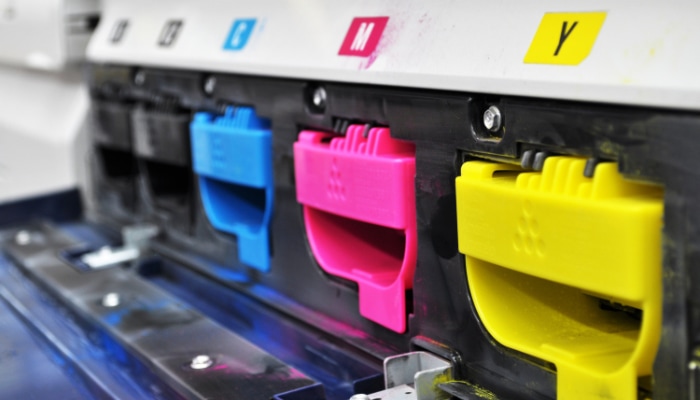How Long Does Printer Toner Last? Factors That Matter

Maximizing the efficiency and cost-effectiveness of our daily printing activities hinges significantly on one often overlooked aspect: the lifespan of printer toner. Diving into the intricacies of toner longevity, we uncover the multitude of factors that influence its lifespan, from the type of toner you choose to the environment where it's stored.
Understanding these nuances is not just about getting the most out of your printer; it's a journey towards more informed decisions in managing your printing resources.
Understanding Printer Toner
Printer toner is a fine powder used in laser printers and photocopiers to form the printed text and images on paper. Unlike liquid ink used in inkjet printers, toner offers a different mechanism of printing, which typically results in sharper and more durable prints.
Composition and Function of Toner
Toner is primarily made of a blend of plastic particles, carbon, and coloring agents which allow it to produce the desired print color. The plastic particles in the toner are melted by the heat of the printer, allowing the toner to fuse onto the paper's surface.
This process contributes to the durability and precision of laser-printed documents.
Types of Toner
There are several types of toner cartridges available in the market:
- OEM (Original Equipment Manufacturer) Toners: These are made by the printer manufacturer and are specifically designed to work optimally with their printers.
- Compatible Toners: Manufactured by third-party companies, compatible toners are designed to work similarly to OEM cartridges but at a lower cost.
- Remanufactured Toners: These are recycled OEM cartridges that have been cleaned, refilled, and tested to ensure they meet quality standards.
Each type varies in cost, print quality, and environmental impact, influencing the choice based on user needs and preferences.
Toner Technology in Laser Printers
Laser printers use a complex process involving a laser beam to produce an image or text on a drum inside the printer. The toner adheres to the areas of the drum that have been touched by the laser, and then it is transferred onto the paper.
The heat and pressure of the printer's fuser unit then melt the toner particles, creating a crisp and durable print.
Factors Affecting Toner Longevity
The lifespan of printer toner is not a fixed metric and can vary significantly based on several factors. From the frequency of printer use to the quality of the toner itself, understanding these variables helps in optimizing toner usage and can lead to cost savings and improved print quality over time.
Print Volume and Usage Patterns
- Frequency of Printing: Regular use of a printer typically leads to quicker depletion of toner. Printers used sporadically may see toner lasting longer, although the quality of prints may degrade over time due to toner settling.
- Type of Documents Printed: Printing large, graphics-intensive documents consumes more toner compared to text-only pages.
Print Quality Settings
- High-Quality vs. Draft Printing: High-quality printing uses more toner to achieve finer details, whereas draft mode conserves toner at the expense of print clarity.
- Resolution Settings: Higher resolution settings require more toner to create detailed images and sharp text.
Storage Conditions
- Temperature and Humidity: Extreme temperatures and humidity levels can affect toner quality and longevity. Proper storage in controlled environments can preserve its lifespan.
- Shelf Life: Toners have a shelf life, and storing them beyond this period can lead to reduced efficacy and print quality.
Toner Design and Quality
- OEM vs. Compatible vs. Remanufactured Toners: The build and design quality of the toner cartridge can influence its efficiency and how long it lasts. OEM cartridges often offer the most reliable performance, but quality compatible and remanufactured options can provide satisfactory results.
- Manufacturing Standards: Higher quality manufacturing processes result in toner that performs better and lasts longer.
Estimating Toner Shelf Life and Page Yield

Evaluating the shelf life and page yield of printer toner is crucial for effective print management and budgeting. These metrics offer insights into how long a toner cartridge will last before needing replacement and help in assessing the overall cost-effectiveness of a printing setup.
Understanding Page Yield
- Definition and Importance: Page yield refers to the estimated number of pages a toner cartridge can print. It serves as a standard measure to compare the longevity of different toner cartridges.
- Typical Page Yield Range: Toner cartridges vary in their page yield, which can range from a few hundred to several thousand pages. A standard toner cartridge, for instance, may yield approximately 2,000 pages, whereas a high-yield cartridge might print around 8,000 pages or more. This variation is dependent on the cartridge and printer model.
- Factors Influencing Page Yield: The actual page yield can vary based on factors such as print density, the complexity of printed documents, and printer settings.
Industry Standards for Page Yield
- ISO/IEC Standards: The International Organization for Standardization (ISO) and the International Electrotechnical Commission (IEC) provide standardized methods for testing page yield, ensuring consistent and comparable results across different toner brands and models.
- Impact of Standards on Consumer Expectations: These standards help consumers make informed decisions by providing a reliable basis for comparing the expected performance of various toner cartridges.
Toner Cartridge Shelf Life
- Defining Shelf Life: The shelf life of a toner cartridge is the period during which the toner maintains its quality and performance when stored properly.
- Factors Affecting Shelf Life: Environmental factors such as temperature, humidity, and exposure to light can significantly impact the shelf life of toner cartridges. Proper storage conditions are essential for preserving their quality.
Real-World Usage and Toner Life
The lifespan of printer toner in real-world usage can significantly differ from theoretical estimates due to a variety of practical factors.
Impact of Printing Patterns on Toner Depletion
- Consistent vs. Intermittent Use: Regular, consistent use of a printer typically results in a steady rate of toner depletion. In contrast, printers used intermittently might experience varied toner life due to factors like toner settling or potential clogging.
- Document Types and Print Density: Frequent printing of high-density documents, such as full-page images or graphics, accelerates toner depletion compared to printing text-dominated pages.
Role of Printer Maintenance
- Routine Cleaning and Servicing: Regular maintenance of the printer, including cleaning and servicing, can help maintain optimal toner usage. A well-maintained printer ensures efficient toner application and reduces wastage.
- Replacing Parts When Necessary: Components like drums, fusers, and rollers play a significant role in toner application and efficiency. Timely replacement of these parts can prevent excess toner usage and improve print quality.
User Habits Influencing Toner Lifespan
- Print Settings Optimization: Adjusting print settings to suit the specific needs of a document (e.g., using draft mode for internal documents) can conserve toner.
- Awareness of Toner Levels: Regularly checking toner levels and understanding the printer's alerts can prevent the overuse of a cartridge, which might lead to poor print quality or potential damage to the printer.
Cost Considerations and Toner Efficiency
The efficiency of printer toner directly influences the overall cost of printing. By evaluating the cost per page in relation to toner lifespan and exploring various toner options, users can make more economical choices.
Analyzing Cost Per Page
- Calculation of Cost Per Page: This involves dividing the cost of the toner cartridge by its page yield. Understanding this metric helps in comparing the real value of different toner options.
- Influence of Toner Type on Cost: OEM cartridges may offer higher quality and reliability but often come at a higher cost compared to compatible or remanufactured cartridges.
Comparing Economic Impact of Toner Types
- OEM Cartridges: While these are generally more expensive, they offer reliability and consistency, potentially reducing the need for reprints.
- Compatible and Remanufactured Cartridges: These options can offer significant cost savings, but it's crucial to choose high-quality products to avoid compromised print quality or potential damage to the printer.
Choosing Cost-Effective Toner Options
- Balancing Quality and Price: It's essential to find a balance between print quality and cost. Sometimes, a slightly higher upfront cost for a better-quality toner can lead to savings in the long run.
- Bulk Purchasing and Contracts: For frequent printing needs, buying toner in bulk or entering into supply contracts can reduce the cost per cartridge.
Tips for Maximizing Toner Efficiency
- Optimal Printer Settings: Using the right settings for each job can reduce toner consumption.
- Regular Printer Maintenance: Ensuring the printer is functioning efficiently can prevent excessive toner usage.
Conclusion
Exploring the intricacies of printer toner longevity has revealed a complex interplay of factors, from the type and quality of the toner to the environment in which it is stored and used. By considering the impact of print volume, quality settings, storage conditions, and real-world usage patterns, users can significantly influence the efficiency and cost-effectiveness of their printing resources.
Moreover, understanding the cost per page and the environmental implications of toner use contributes to a more strategic approach to printing. With these insights, individuals and organizations can optimize their printer toner usage, ensuring quality prints while managing expenses and environmental impact.
The key takeaway is that with careful consideration and maintenance, it is possible to extend the life of printer toner, making it a savvy and sustainable choice for everyday printing needs.


